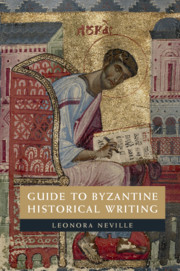Book contents
- Frontmatter
- Dedication
- Contents
- Acknowledgments
- Introduction
- Byzantine Historical Texts
- 1 Theophylakt Simokatta
- 2 Paschal Chronicle
- 3 George Synkellos
- 4 Chronicle of Theophanes
- 5 Patriarch Nikephoros
- 6 Scriptor Incertus de Leo V
- 7 Chronicle of 811
- 8 Megas Chronographos
- 9 George the Monk
- 10 Peter of Alexandria
- 11 Genesios
- 12 Theophanes Continuatus
- 13 Constantinian Excerpts
- 14 John Kaminiates
- 15 Symeon the Logothete
- 16 Leo the Deacon
- 17 Chronicle of Monemvasia
- 18 Chronicon Bruxellense
- 19 Psellos
- 20 John Xiphilinos
- 21 Michael Attaleiates
- 22 John Skylitzes and Scylitzes Continuatus
- 23 George Kedrenos
- 24 Nikephoros Bryennios
- 25 Anna Komnene
- 26 John Kinnamos
- 27 John Zonaras
- 28 Constantine Manasses
- 29 Michael Glykas
- 30 Eustathios of Thessaloniki
- 31 Joel
- 32 Niketas Choniates
- 33 George Akropolites
- 34 Theodore Skoutariotes
- 35 George Pachymeres
- 36 Nikephoros Gregoras
- 37 Ephraim
- 38 Constantine Akropolites the Grand Logothete
- 39 Chronicle of Morea
- 40 Nikephoros Kallistos Xanthopoulos
- 41 John VI Kantakouzenos
- 42 Michael Panaretos
- 43 Chronicle of Ioannina
- 44 Chronicle of Tocco
- 45 John Kananos
- 46 John Anagnostes
- 47 Leontios Machairas
- 48 Sylvester Syropoulos
- 49 Doukas
- 50 George Sphrantzes
- 51 Michael Kritovoulos
- 52 Laonikos Chalkokondyles
- Appendix A Time Periods Covered in the Histories
- Appendix B Timeline of Authors’ Lives
39 - Chronicle of Morea
from Byzantine Historical Texts
Published online by Cambridge University Press: 14 June 2018
- Frontmatter
- Dedication
- Contents
- Acknowledgments
- Introduction
- Byzantine Historical Texts
- 1 Theophylakt Simokatta
- 2 Paschal Chronicle
- 3 George Synkellos
- 4 Chronicle of Theophanes
- 5 Patriarch Nikephoros
- 6 Scriptor Incertus de Leo V
- 7 Chronicle of 811
- 8 Megas Chronographos
- 9 George the Monk
- 10 Peter of Alexandria
- 11 Genesios
- 12 Theophanes Continuatus
- 13 Constantinian Excerpts
- 14 John Kaminiates
- 15 Symeon the Logothete
- 16 Leo the Deacon
- 17 Chronicle of Monemvasia
- 18 Chronicon Bruxellense
- 19 Psellos
- 20 John Xiphilinos
- 21 Michael Attaleiates
- 22 John Skylitzes and Scylitzes Continuatus
- 23 George Kedrenos
- 24 Nikephoros Bryennios
- 25 Anna Komnene
- 26 John Kinnamos
- 27 John Zonaras
- 28 Constantine Manasses
- 29 Michael Glykas
- 30 Eustathios of Thessaloniki
- 31 Joel
- 32 Niketas Choniates
- 33 George Akropolites
- 34 Theodore Skoutariotes
- 35 George Pachymeres
- 36 Nikephoros Gregoras
- 37 Ephraim
- 38 Constantine Akropolites the Grand Logothete
- 39 Chronicle of Morea
- 40 Nikephoros Kallistos Xanthopoulos
- 41 John VI Kantakouzenos
- 42 Michael Panaretos
- 43 Chronicle of Ioannina
- 44 Chronicle of Tocco
- 45 John Kananos
- 46 John Anagnostes
- 47 Leontios Machairas
- 48 Sylvester Syropoulos
- 49 Doukas
- 50 George Sphrantzes
- 51 Michael Kritovoulos
- 52 Laonikos Chalkokondyles
- Appendix A Time Periods Covered in the Histories
- Appendix B Timeline of Authors’ Lives
Summary
The Chronicle of Morea is a history of the Frankish Peloponnese, focusing on the Principality of Morea in the thirteenth century. It survives in a Greek verse version and French, Italian, and Aragonese prose versions. The diverse versions of the history reflect the cultural mixture of the society in which the text was composed. The Greek and Italian manuscripts end in 1292. The French version ends in 1333 and the Aragonese version runs from 1200– 1377.
In most of the extant manuscripts, the Chronicle opens with a prologue describing the beginnings of the Crusades, including the events of the Fourth Crusade and the sack of Constantinople. It then describes the Crusaders’ conquest of the Peloponnese and the formation of the principality of Morea. Thereafter follows an account of its government under Geoffrey I de Villehardouin (1209/ 10– 1229) and his successors, up to the reign of Isabelle de Villehardouin. One manuscript also covers the war of succession that followed Isabelle's death. The Chronicle includes a great deal of information regarding court proceedings, council deliberations, and diplomacy, alongside political and military developments in the principality of Morea.
Due to its numerous documented factual errors, the Chronicle has been criticized as an unreliable historical source. Teresa Shawcross believes that it nonetheless provides important clues about how history was imagined and reconstructed by contemporaries.
Shawcross argues that the chronicle was most likely begun in the mid- 1320s and subsequently enlarged and modified over the following two decades. She sees the text as written during a period of crisis in the principality and representing an attempt to conjure up a mythical past in which Greeks and Latins lived in harmony and forged a new collective identity. Harold Lurier, however, prefers a slightly earlier date of composition – somewhere between 1304 and 1314. The text has a high level of detail, and seems not to rely on other sources. This suggests that the author or authors lived in the region it describes and witnessed many of the events in question firsthand.
Information
- Type
- Chapter
- Information
- Guide to Byzantine Historical Writing , pp. 254 - 259Publisher: Cambridge University PressPrint publication year: 2018
